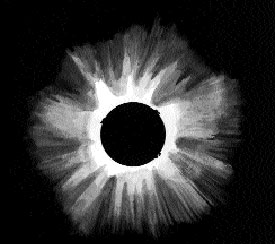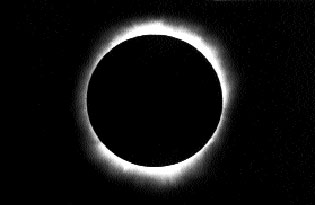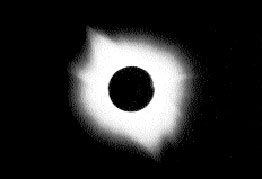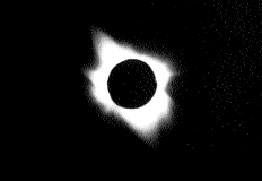|
Observe Eclipses!
|
|
Introduction. As totality or very deep annularity arrives, the pearly–white solar atmosphere flashes into view surrounding the new moon’s darkened disk. Known by such colorful names as “halo” and “glory” from earliest times, this is the corona, a tenuous region of free electrons and interplanetary dust extending millions of kilometers into space and shining in the eclipse sky with the intensity of the full moon.
Mention of the corona appears in literature dating back to a description of the 20 March 71 solar eclipse in Plutarch’s dialogue On the Face in the Orb of the Moon. It was not until the eclipses of 8 July 1842 and 28 July 1851 that the corona was positively associated with the sun instead of the moon. The inner or K–corona, composed largely of electrons, displays a continuous spectrum and provides a backdrop for viewing prominences. The outer dust or F–corona has an absorption spectrum, extends for several solar diameters, varies in shape from eclipse to eclipse but is generally irregular, and features spectacular radial streamers. Procedures for observing the corona should focus on its shape and extent, intensity variations and streamers. Shape and extent. The sun’s corona varies from a generally uniform and circular appearance around times of sunspot maximum to a highly irregular one near sunspot minimum. Measuring the shape and extent of the sun’s corona is a project well–suited for the observer without special optical equipment. This may be done descriptively with the aid of a tape recorder (and hand–held reticle for estimating position angle), or artistically using rough sketches or “mapping” techniques. Many science, engineering and surveying supply houses sell inexpensive glass reticles etched with bull’s–eyes, linear scales and azimuth circles. An excellent home–made combination bull’s–eye or linear scale and azimuth circle may be drawn, then photographed or photocopied onto transparency film. When mounted in a cardboard viewing tube, it is a simple matter to sight on the eclipsed sun and orient the azimuth circle’s “zero degree” position with the sun’s north pole. The corona’s extent may then be called out and tape recorded in terms of solar radii at chosen position angle intervals. Experienced sketch artists may accomplish the same thing by pre–sketching a landscape feature close to the eclipsed sun, then using the feature for scale and orientation when roughing in the corona’s shape and extent during totality. Those having less artistic skill may wish to attempt a rough diagramming technique known as mapping, where a circle to represent the eclipsed sun is drawn in the center of a sheet of graph paper, and the surrounding squares are shaded in during totality to match the appearance of the corona. Intensity variations. The corona does not exhibit the same brightness intensity throughout. These subtle differences, which occur both radially and circumferentially with respect to the sun, are caused by variations in the density of the coronal gases and tend to “wash out” in photographs. However, using techniques similar to those employed for shape and extent observations, the uneven texture of the corona’s brightness may be readily described or sketched. Descriptions may be recorded in terms of position angle and extent using a five–step linear scale, where 0 is the darkest (the appearance of the moon’s center at mid–eclipse, or of the surrounding sky) and 5 is the most brilliant part of the corona. Sketch artists will want to employ a heavier stroke to emphasize brighter regions, while mappers might use the same 0–5 intensity scale to outline changes within the squares on their graph paper in a “paint by numbers” approach.
Streamers. These long finger–like strands near equatorial regions and short fan–shaped appendages near the poles of the sun align themselves with the sun’s magnetic field. They also vary significantly in number, structure and distribution throughout a sunspot cycle. Estimates of their number, along with descriptions of the shapes, position angles and extents of the more prominent streamers, might be undertaken. Sketch artists, especially those equipped with binoculars or low–power telescopes, might want to make detailed renderings of the more spectacular streamers. Photography. The corona—in fact, totality itself—was photographed successfully for the first time by Berkowski at the eclipse of 28 July 1851; using the 15.9 cm (6.25 in) Königsberg heliometer, he required an exposure of 24 seconds. Fortunately, modern photographic emulsions offer much greater versatility.
With any diffuse subject like the corona, its appearance on film is a function of the exposure time and f/–stop used. There is wide latitude and ample time to shoot a sequence at different settings, from the shortest exposure likely to produce an image to time exposures as long as 15 seconds for moderately fast films (around ISO 200). Shorter exposures will capture greater structural detail in the inner corona, enhancing the streamers, while failing to capture the impressive extent of the outer corona; longer exposures do justice to the outer corona, while washing out the other details. Skilled darkroom or computer technicians can combine individual exposures to create composite images which capture the best of both extremes. Video photography should be attempted with automatic focus and exposure features disengaged, since they prove highly unreliable under low lighting conditions. Experiment in advance with the full moon, and settle on a range of f/–stops and focal lengths which show detail on lunar surface features. This should provide an adequate mid–range for coronal photography with most camcorders. Viewing dangers. During totality there is no danger to the eyesight from solar radiation. It is safe to view the corona and coronal streamers without special filters, even through optical devices. However, it is crucial that care be taken to discontinue any direct visual viewing before third contact, when the sun’s disk is again exposed to view. A countdown tape with built–in several–second margin of error and attention–getting signal, or a timekeeper serving the same purpose, will provide a reliable warning system.
|



